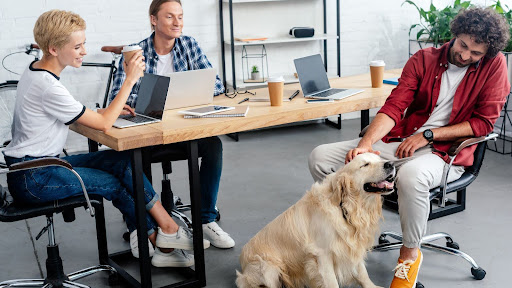Incorporating an Office Dog Into Your Workspace

Introducing a dog into the workplace can transform mundane office days, offering employees the benefits of canine companionship. The benefits of having a dog in the office don’t just stop at getting to cuddle with a furry friend during coffee breaks, it means fostering a culture of wellbeing, creativity, and connectivity.
However, blending barks with business requires thoughtful consideration and planning. From understanding the unique needs of employees to ensuring the office is a safe and welcoming space for four-legged friends, there are several key factors to address.
Benefits of an Office Dog
Dogs are a man's best friend and the presence of one can positively impact various facets of office life. From boosting morale and fostering a culture of inclusivity to managing stress and encouraging healthier work habits, an office dog offers a host of benefits to a workplace.
1. Improved Well-being
Research has consistently highlighted the psychological benefits of interacting with pets, including reduced anxiety, lower blood pressure, and increased levels of serotonin and dopamine. In an office setting, these effects translate into more relaxed and happier employees, leading to a more cohesive and collaborative work environment.

2. Businesses with Pets are Seen as Progressive
Pets in the office convey the impression of a modern and forward-thinking company. Most people react positively when they meet an office dog, and it can put them at ease. An office pet can also be an encouraging sign for potential customers and employees as a company that loves and looks after animals is likely to look after its clients and staff. A ‘bring your pet to work policy’ can also lead to a lower absence rate and boost employee morale.
3. Improved Communication and Collaboration
As humans, we crave connection with our fellow beings, yet we also tend to hide behind our screens, especially in a workspace. Having a dog in the office can break down barriers and make it easier to talk to colleagues. Observing your pet and how it interacts with people and other pets can bring people together and become a talking point. When working on company projects, the presence of a dog can promote cohesiveness in a team and foster a positive attitude toward one’s peers.
4. Attract and Retain the Best People
According to a recent study conducted by HABRI, the presence of a pet-friendly environment influences employee retention, with 88% of workers at such companies planning to remain for at least the next year, as opposed to 73% at companies without a pet-friendly policy. With pets being a significant part of most people’s lives, dogs in an office space can help companies attract and retain the best talent.
5. Dogs Encourage Fun
Best of all, dogs love to play! One of the most modern office must-have items of furniture is the touchdown table. And no, that isn’t an American football pitch on a table, it is a multipurpose surface which has a mix of surfaces set at different heights. Great for a quick chat, noting down an idea, or working with your dog near to hand (or heel). Be it scoring a touchdown and succeeding at work or walking the dog around the office, have fun and have a great day!
Here is a video that shows the importance of bringing your dog to work!
Things to Consider When Incorporating a Dog Into a Workplace
While the idea of bringing a dog into the workplace is filled with positive intentions and potential benefits, it's a decision that requires careful thought and consideration. Learn how to navigate the challenges that may arise when introducing a four-legged friend into a professional setting.
Right Pet, Right Furniture
Furniture is part and parcel of your workplace culture and trends change over time. New ways of thinking mean that people work in break-out areas, at sit-stand desks, and touchdown spaces, each of which is carefully ergonomically designed for specific purposes. When incorporating a dog into the workplace, we have a duty of care to ensure they are comfortable and happy, that they have ample room to move about, and that there is privacy should they want to chill. It is also key that colleagues and customers alike are comfortable and at ease with their presence.
If your workplace wouldn’t suit a dog, all sorts of pets can be brought to work or live on the premises. From fish for Feng Shui to lazy lizards, slithery snakes, stick insects, and chirpy birds, the right pet for the office can make all the difference.
Before you consider taking your dog to work, think it through. Would your dog be happy in the space, is your dog’s temperament suited to the office?

Bringing your Dog to Work: Training
So, your work has agreed for you to bring your dog to work. Dogs like to know the rules and a new environment may require new rules for you and your dog. You may need to make accommodations to ensure your dog is comfortable and well looked after. Take time to show your dog around. We all like to be shown around a new office environment and your dog will appreciate time spent giving him some pointers.
Prepare your dog for all sorts of scenarios and personalities. Good training may help your dog adapt to different voices, behaviours, and the unexpected. You can have a lot of fun with this and begin to learn a lot for your survival too. Imitate real people and real scenarios, be honest.
Hygiene is Essential for Your Dog in the Office
Give your dog a good bath and clean before work and make sure that there are adequate comfort breaks once you are there. You could also ensure a manicure and toothbrush before imposing dog breath on everyone.
Schedule Suitable Exercise
Does your dog like to doze about until you nudge it to go for a walk or need loads of exercise to wear off excess energy? You know your dog, try to give it the exercise it needs and feels comfortable with whilst you are at work. You may need to write yourself a schedule that includes your dog's needs. This may be beneficial for you too and improve your work experience and productivity.
What Type of Dog Can You Realistically Fit in Your Office?
Whatever your workplace is like, meeting the right requirements is essential for comfort and productivity. A Jackapoo is a Jack Russell and Poodle cross, it is a small dog suitable for most workplaces. On the other hand, a Labradoodle, which is a Poodle and Labrador cross can potentially be a larger dog and more suitable for an office with room to move about freely.
Of course, when we say what dog can you realistically fit in your office, this is a real consideration as a dog or other animal needs room to roam. A very large building with lots of space to move about may be suitable for a large dog.
Toy Dogs
It is increasingly on-trend to own modern cross-breed and toy dogs. Controversially, they are being bred for size and convenience as well as looks. Crufts has taken the step to ban certain breeds from the show, with good reason, there can be all sorts of health issues with certain breeds. Whilst dogs have been bred for purpose for centuries, “Toy” dogs are a relatively new phenomenon, shock horror, they are also real, a factor that can be overlooked.
Humans have a habit of humanising objects and animals and this can be a hazard, a problem that led to the original RSPCA campaign, “Dogs are for life, not just for Christmas”. When the novelty of owning a ‘toy’ dog wears off and the reality sets in, owners can find they have a problem on their hands. But it is not all doom and gloom. “Toy” dogs can bring a responsible owner a lot of pleasure.
Meet our friend, Sheridan
Six rectangular desks with cantilevered legs, an open floor space, a pot plant, coffee cups, and an immediate greeting from Sheridan, the gentle honey-coloured Spaniel who walks straight from the opposite end of the room to greet me. He transforms the atmosphere immediately from functional to welcoming.
“Are you ok with dogs?” Ok? I might not have been, on the contrary, his presence made the office more inviting. He was a pleasant distraction from the unnerving knowledge that as you spoke to one person, everyone could hear everything and the awkwardness of being referred from one desk to another, the neighbouring desk, all lessened by the friendly team and Sheridan, of course.
Sheridan is the meet and greet of the team, a bond formed between colleagues, he has one of the most important jobs in the small office, boosting morale and putting customers at ease. The team works together to take him for short walks, feed him, and make sure his needs are met. Sheridan, on the other hand, sits quietly but requires love and attention between tasks. Sheridan is an example, but a recent visit to a similar office space and meeting their dog inspired his character.
Each dog has a personality to consider; when bringing a pet to work, make sure both people and pets are going to be happy. The RSPCA policy on dogs at work is that all workplaces should have an “animals’ in the workplace policy”. They also stipulate that a dog owner should ensure that their dog is kept under control in an appropriate manner to ensure their welfare and safety.